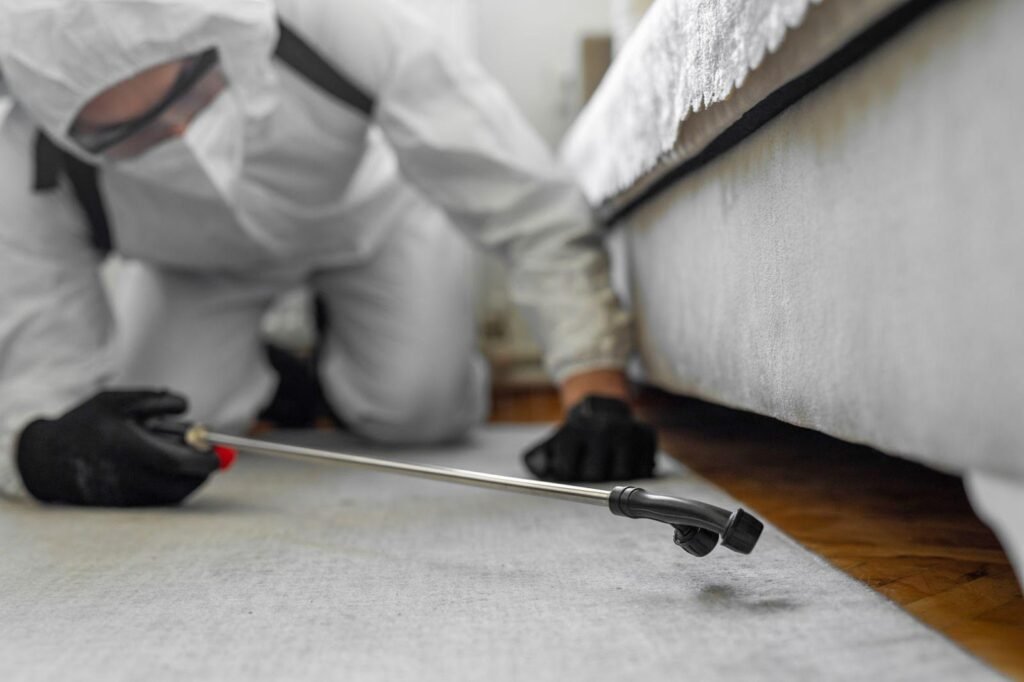
5 Common Household Pests in Calgary and How to Prevent Them
Calgary homes often face invasions from pests like rodents, ants, spiders, bedbugs, and cockroaches. These pests can cause damage, spread diseases, and disrupt daily life. Prevention is key — seal cracks, maintain cleanliness, and eliminate food sources to keep them at bay. For persistent infestations, professional pest control services provide effective, tailored solutions. Understanding pest behavior and taking proactive steps helps secure a pest-free home while safeguarding your family’s health and property.
Table of Contents
- Common Pests in Calgary Homes
- Prevention Tips for Each Pest Type
- When to Call Professional Pest Control Services
Living in Calgary offers a unique blend of urban convenience and natural beauty, but it also comes with its share of challenges — like dealing with household pests. From rodents seeking warmth during harsh winters to ants marching through kitchens in search of food, these unwelcome guests can disrupt your peace and damage your property. Beyond the nuisance factor, pests pose health risks, contaminate surfaces, and even compromise structural integrity.
Taking preventive measures early can save you time, money, and stress. Simple habits like sealing cracks, decluttering spaces, and maintaining cleanliness go a long way in deterring pests. However, when infestations become overwhelming, professional pest control Calgary offer reliable solutions tailored to your needs. By staying informed and proactive, you can protect your home and family from these persistent intruders.
Common Pests in Calgary Homes
Calgary’s climate and urban environment make it a hotspot for certain types of household pests. Understanding these pests, their behaviors, and the threats they pose is the first step toward effective prevention. Below, we explore five of the most common culprits that invade Calgary homes.
1. Rodents
Rodents like mice and rats are a year-round issue in Calgary, but they’re especially problematic during colder months when they seek shelter indoors. These pests are notorious for chewing through electrical wires, insulation, and even wood, causing costly damage.
- Behavior: Nocturnal creatures that build nests in attics, basements, or wall voids.
- Signs of Infestation: Droppings, gnaw marks on furniture or wiring, scratching noises at night.
- Health Risks: Rodents can carry diseases such as hantavirus, salmonella, and leptospirosis, which can spread through their droppings or urine.
2. Ants
Ants are drawn to food sources, particularly sugary or greasy items left out in kitchens. While most ants are harmless, carpenter ants can cause significant structural damage by tunneling through wood.
- Behavior: Ants leave pheromone trails to guide others to food, making infestations grow rapidly.
- Signs of Infestation: Visible trails of ants, small piles of sawdust (from carpenter ants), or winged ants during mating season.
- Health Risks: Minimal direct health risks, but they contaminate surfaces and food.
3. Spiders
While spiders play a role in controlling other insect populations, some species — like black widows — are dangerous. Spiders thrive in dark, undisturbed areas like basements, garages, and closets.
- Behavior: Most spiders are solitary and shy, but their webs and egg sacs can quickly multiply their numbers.
- Signs of Infestation: Cobwebs in corners, visible spiders, or egg sacs near ceilings or windows.
- Health Risks: Spider bites can cause pain, swelling, or allergic reactions, depending on the species.
4. Bedbugs
Bedbugs are tiny, nocturnal pests that feed on human blood, leaving itchy welts on the skin. Once established, bedbug infestations are notoriously difficult to eliminate without professional help.
- Behavior: Hide in mattresses, box springs, furniture cracks, and baseboards, emerging at night to feed.
- Signs of Infestation: Red, itchy bite marks, dark spots on bedding, musty odor, or shed exoskeletons.
- Health Risks: Primarily cause skin irritation and sleep disturbances due to discomfort.
5. Cockroaches
Cockroaches are resilient pests that thrive in damp, warm environments. They’re often found in kitchens, bathrooms, and basements, where they feed on crumbs and organic matter.
- Behavior: Nocturnal and fast-moving, cockroaches scatter when disturbed.
- Signs of Infestation: Fecal droppings resembling coffee grounds, foul odors, or shed exoskeletons.
- Health Risks: Known carriers of bacteria, cockroaches can trigger asthma, allergies, and foodborne illnesses.
Prevention Tips for Each Pest Type

Preventing pests from invading your home requires a combination of cleanliness, structural maintenance, and proactive measures. Below, we’ve compiled targeted tips for each pest type to help you stay one step ahead.
1. Rodents
To keep rodents like mice and rats at bay:
- Seal Entry Points: Inspect your home for gaps around windows, doors, and foundations. Use steel wool or caulk to seal cracks, as rodents can squeeze through openings as small as a dime.
- Eliminate Food Sources: Store pantry items in airtight containers and avoid leaving pet food out overnight.
- Use Traps Strategically: Place snap traps or humane traps along walls where rodents travel, focusing on areas like basements and attics.
2. Ants
Prevent ants from marching into your kitchen with these steps:
- Clean Regularly: Wipe countertops, sweep floors, and clean up spills immediately to remove food residue.
- Seal Cracks: Apply silicone caulk to seal cracks in walls, windows, and baseboards where ants may enter.
- Address Moisture Issues: Fix leaky pipes and reduce humidity, as ants are attracted to damp environments.
3. Spiders
Reduce spider populations by targeting their habitats and food sources:
- Declutter Spaces: Remove piles of boxes, papers, and unused items where spiders like to hide.
- Vacuum Frequently: Use a vacuum to remove webs, egg sacs, and spiders from corners and ceilings.
- Install Door Sweeps: Prevent spiders from entering through gaps under doors by installing door sweeps or weather stripping.
4. Bedbugs
Stopping bedbugs before they settle in is crucial:
- Inspect Secondhand Items: Carefully examine used furniture, mattresses, and clothing for signs of bedbugs before bringing them into your home.
- Wash Bedding Often: Launder sheets, pillowcases, and mattress covers in hot water weekly to kill any hitchhiking bugs.
- Encase Mattresses: Use protective mattress and box spring encasements to prevent bedbugs from hiding in crevices.
5. Cockroaches
Keep cockroaches from thriving in your home with these strategies:
- Fix Leaks Promptly: Repair dripping faucets and secure proper drainage to eliminate water sources.
- Dispose of Garbage Properly: Use sealed trash bins and take out the garbage regularly to avoid attracting roaches.
- Apply Gel Baits: Place gel baits in hidden corners, behind appliances, and under sinks to target hard-to-reach areas.
When to Call Professional Pest Control Services
While DIY prevention methods are effective for mild pest issues, some infestations require professional intervention. Knowing when to call in the experts can save you time, money, and frustration. Here’s how to recognize when it’s time to seek professional help:
1. Persistent Infestations
If you’ve tried traps, baits, and cleaning routines but pests keep returning, it’s a sign that the problem may be more extensive than you realize. Professionals have access to advanced tools and techniques to identify hidden nests or entry points that homeowners might miss.
2. Large-Scale Infestations
Discovering multiple signs of pests — such as widespread droppings, extensive damage, or large numbers of insects — indicates a severe infestation. For instance, a full-blown bedbug problem often requires specialized heat treatments or chemical applications that only trained technicians can perform safely.
3. Health and Safety Concerns
Certain pests, like rodents or cockroaches, pose significant health risks by spreading bacteria, allergens, or diseases. If family members experience unexplained allergies, asthma flare-ups, or illnesses, it may be linked to a pest problem. Professionals can assess the situation and implement solutions to mitigate these risks.
4. Structural Damage
Pests like termites or carpenter ants can cause costly damage to your home’s structure. If you notice sagging floors, hollow-sounding wood, or cracks in walls, it’s crucial to act quickly. Pest control experts can conduct thorough inspections and recommend targeted treatments to prevent further damage.
5. Peace of Mind
Even if the infestation seems manageable, some homeowners prefer the expertise of professionals for peace of mind. Certified pest control services in Calgary use environmentally responsible methods and cutting-edge technology to secure long-term results without compromising safety.
Final Thoughts: Staying Ahead of Pests
Protecting your Calgary home from pests is an ongoing process that requires vigilance, consistency, and adaptability. While understanding the habits and prevention strategies for common pests is crucial, staying proactive is equally important. Regular inspections, prompt action, and a clean, clutter-free environment can significantly reduce the likelihood of infestations.




